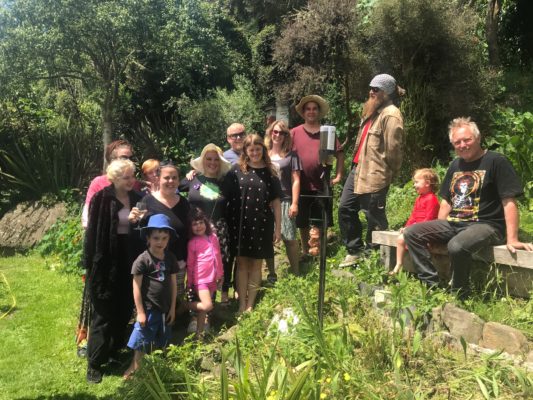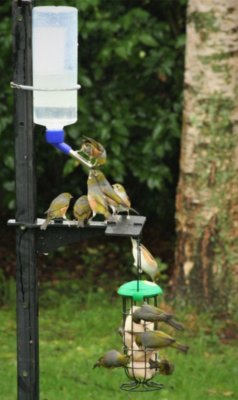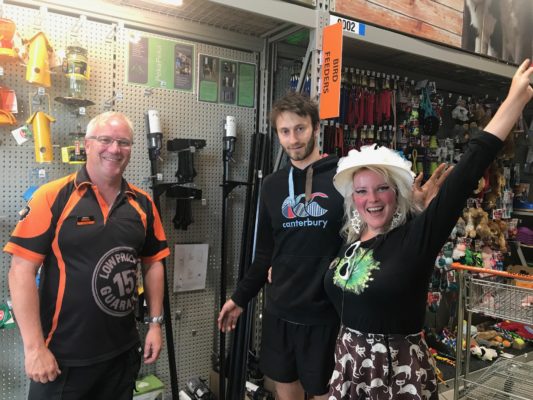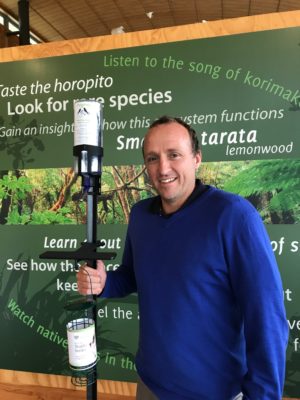Harvey Penfold is a product design student, in his final year at Otago Polytech, Tahu Mackenzie is LEOTC (Learning Experiences Outside the Classroom) Education Officer at Orokonui Ecosanctuary just north of Dunedin and together they’ve designed an innovative bird-feeder. The PekaPeka was designed and tested as part of a Citizen Science project that is ongoing in their Northeast Valley community.

“The project is called Open VUE – Open Valley Urban Ecosanctuary,” Tahu explains. “The aim is to have safe backyard spaces as birds like the kākā spread out from Orokonui, beyond the Halo (a predator control project surrounding Orokonui Sanctuary), and into Dunedin’s Northeast Valley. The kākā living in Dunedin Botanic Gardens’ aviaries will also attract wild kākā spreading out from Orokonui to head towards Northeast Valley.”
So conservationists and community members have been working together to provide a safe Valley welcome for Orokonui’s spillover birds.
“Orokonui and the University of Otago have been working alongside the Northeast Valley community,” says Tahu, “with nine schools and 120 cat-owning Valley families taking part. With ‘Unlocking Curious Minds’ citizen science projects, you have a scientist facilitator, an educational component to the project and community engagement,” she explains. “Scientist Clare Cross and I had already carried out a cat tracking project called ‘How Safe Is My Cat?’ and Open VUE was looking for more projects to follow on from that.”

Coming up with a bird feeder that encouraged visiting birds without putting them at risk from family cats was an ideal project. Harvey and Tahu knew that a lot of Northeast Valley families would love to feed birds in their garden but worried – with good reason – that their bird table might end up being a drop-in buffet for their own or their neighbour’s cats. Even hanging a bird feeder from a tree branch, can result in the tree itself obscuring a bird’s view of stalking predators.
“The feeder design had to be standardised for scientific measurability,” says Tahu. “It needed to feed different species at the same time and it needed to be able to be put anywhere easily.”
First Tahu and Harvey needed to work out how to feed both sugar water and fat/seed-based foods to a variety of birds.
“There were lots of drawings and late-night discussions coming up with the platform design,” says Tahu. “But now it seems obvious.”
The prototype feeders were then set up in in the gardens of 120 cat owning families around Northeast Valley.
“The feeders had fat, fruit and seed and a trail camera was set up 1.5 metres away to record what birds ate what foods,” says Tahu. “We are keen to support native species and a lot of overseas products are for feeding seed, which the introduced species eat. The introduced species are already out-competing natives.”

Making sure the feeder was ‘predator resistant’ was a priority.
“We’ve used a metal waratah,” says Tahu. “There’s no grip for cats and rats. Cats are ambush predators, but the waratah gives birds 360 degrees of vision whilst they feed. You can put the PekaPeka anywhere and its safe because the cats are easily seen. Food doesn’t have to be put in a tree.”
Harvey and Tahu also noticed how the birds would learn from each other as they became familiar with the feeders.
“The silvereyes would come in first. They’re confident and inquisitive because they’re part of a flock,” says Tahu. They’d feed on the energy truffles (fat based) and sugar water feeder. The bellbirds and tūī were solo feeders. They’d sit and watch at first, then come in and be bossy.
They found that having both sugar and truffles at the start was best for learning. Later, the truffles can be replaced by fruit.
“The sugar water and truffles can also feed kākā,” says Tahu. “The feeding platform has been designed to hold 1kg so that it can take a kākā’s weight.”
Harvey and Tahu teamed with Mitre 10 in Dunedin to produce the prototype feeders.
“Mitre 10 sponsored the gear for the experiment, then when we met with them and showed the photos from the trail camera, they said ‘this is fantastic – can we sell it?’” says Tahu.

Other local firms have also shown their support.
“Initially we cut the bird-feeders ourselves from plastic,” Harvey explains, “But now the PekaPeka platform is injection moulded by Mosgiel plastics engineering firm JTech. Jason Hollis from JTech has been very supportive and it’s good to keep production local.”
The project also got a huge boost when Harvey, who is a product design student, entered the Pekapeka into the Audacious Business Awards (run by the University of Otago and Otago Polytechnic for students). It won!
“The award launched us into business,” he says. “As part of the prize we were given $5000 for start-up funding which we used for the JTech injection moulding of the PekaPeka platform. We had a website made for us by ‘Firebrand’, got legal advice from Webb Farry – and were given a cell phone. Later we used another $5000 raised from sales to produce the ‘Nectar Nest’ design, instead of the early designs where the sugar water bottle was held by a spring.”
[Incidentally, Harvey and Tahu are keen for anyone who bought the early ‘spring-held’ models to contact them and they’ll replace the spring with a ‘Nectar Nest’.]

Currently the PekaPeka Bird Feeder, is for sale through the PFNZ Trust online shop and is also sold at Dunedin and Mosgiel Mitre 10 stores, the Department of Conservation in Queenstown and Orokonui Ecosanctuary. Online sales are minus the metal waratah – a standard Jobmate waratah available at Mitre 10 stores which would be impossibly expensive to post!
Later this year the couple hope that the PekaPeka will be available at Mitre 10 stores nationwide. Tahu and Harvey have also been talking with Oamaru-based family firm ‘Topflite’, about putting together a combined bird-feeding package of PekaPeka nectar nest, feeding platform and bottle for sugar water, along with a Topflight truffle feeder and energy truffles.
“A lot of schools use the Pekapeka – about 35 schools in Dunedin,” says Tahu, “And it’s used by 5 Dunedin retirement villages too. Nationally we’ve sold and posted about 800 kits (minus those waratahs) so far.”
A safe feeder does more than just stop birds getting hungry.
“The birds are surveyed every month,” says Tahu, “And since we’ve been supplementary feeding them, the numbers have increased, because they may choose to breed twice in a season: ‘The more you feed, the more they breed’!” she says.
The PekaPeka is for sale in our online shop.

